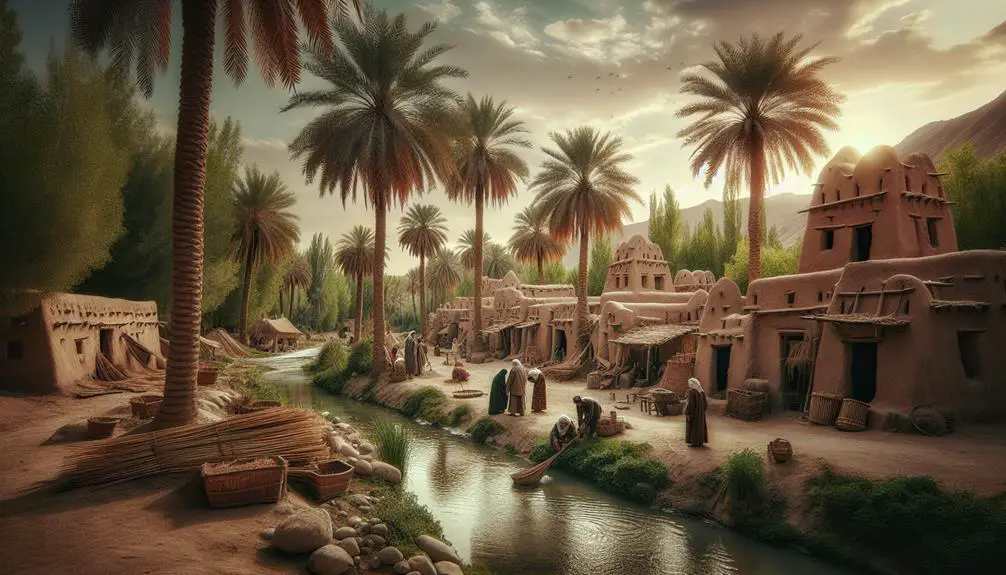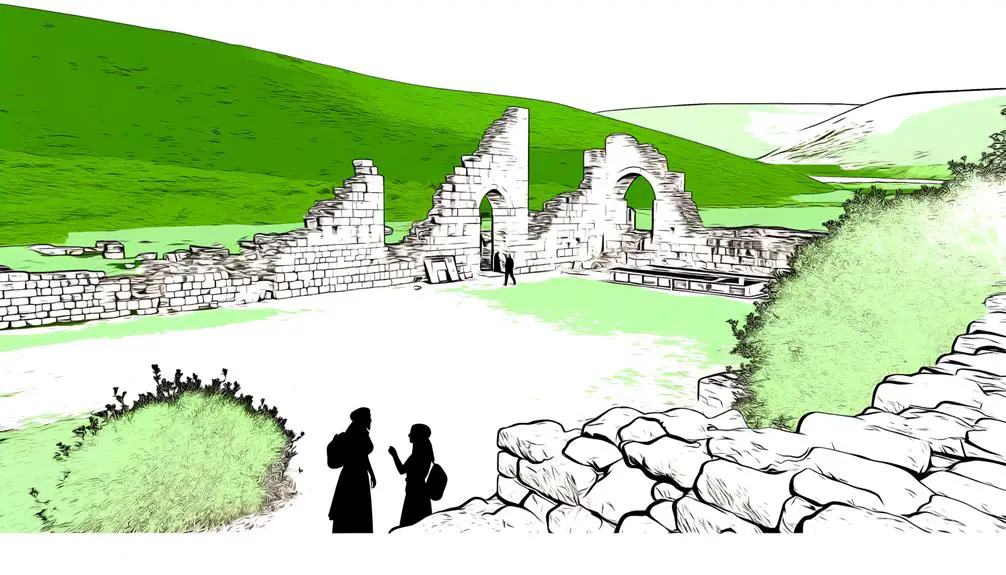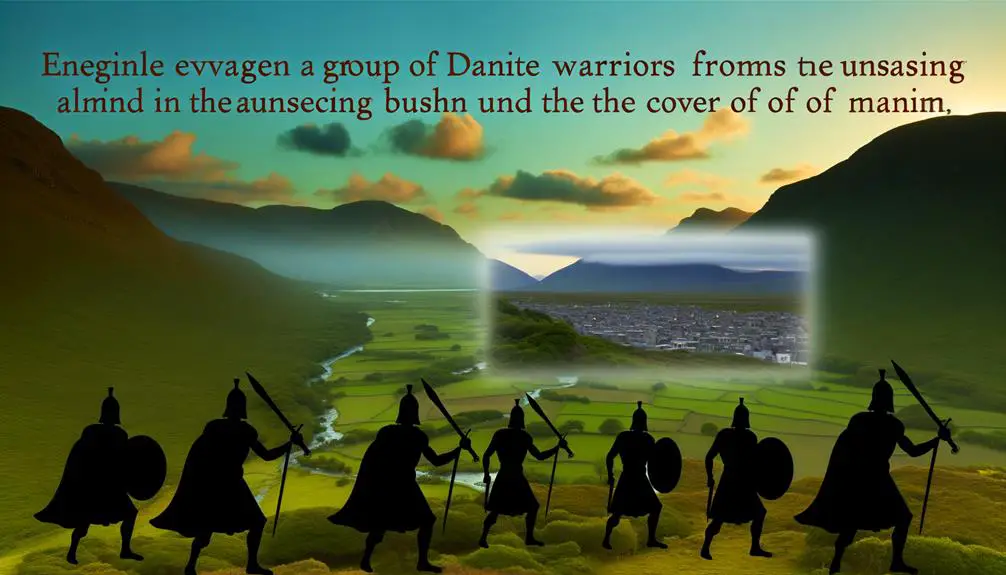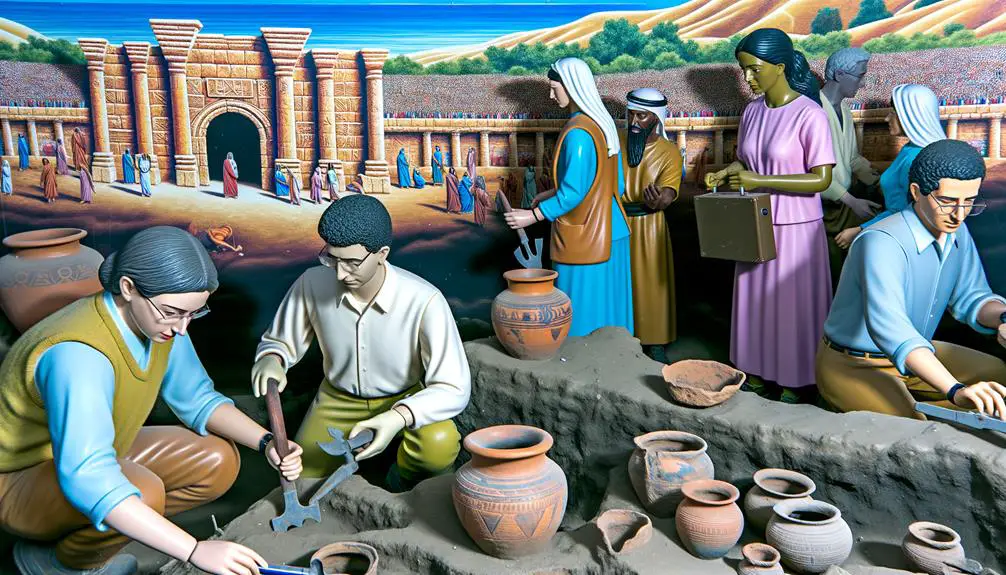Journey into the ancient city of Laish in the Bible, where secrets and stories await to unveil its profound historical and spiritual significance.

Laish in the Bible
As they say, 'Rome wasn't built in a day,' and similarly, the biblical city of Laish didn't just appear in the annals of history without a backstory.
You might find it intriguing to learn how Laish, mentioned in the Bible, offers a unique lens through which to view the ancient world, especially when considering its capture by the Danites. This event not only highlights the strategic importance of Laish but also opens up discussions on the archaeological insights that shed light on its historical authenticity.
If you're curious about the spiritual significance tied to this ancient city, there's more to uncover about its impact on biblical narratives and its role in the unfolding story of the Israelites.
Key Takeaways
- Laish's capture and renaming to Dan signifies divine guidance and redefined tribal territories in biblical history.
- The city's strategic location and role in ancient trade routes underscore its economic and historical significance.
- Archaeological findings in Laish provide tangible connections to its past, highlighting its enduring legacy in the ancient world.
- Laish/Dan's spiritual significance is reflected in biblical narratives, demonstrating themes of transformation, divine judgment, and redemption.
The Historical Laish

The historical Laish, often identified with the later Dan, serves as a pivotal settlement in ancient Near Eastern history, revealing significant insights into the socio-political and religious dynamics of the period. Its geographic location, nestled at the northernmost tip of the land bridge connecting Africa and Asia, positions Laish as a critical node in ancient trade routes. This strategic placement didn't just influence its economic prosperity; it also made Laish a melting pot of various cultures and religions that traversed these routes.
You'll find that Laish's significance is further underscored by its role in regional trade networks. Its proximity to major water sources and the fertile lands of the Hula Valley made it an attractive destination for traders. The city's location facilitated the exchange of goods from as far as Egypt and Mesopotamia, making it a bustling hub of commerce and interaction. This trade not only brought wealth but also ideas, practices, and innovations, profoundly shaping the social and religious fabric of Laish.
Moreover, the city's strategic importance can't be overstated. Controlling Laish meant controlling access to the lucrative trade routes that passed through it. Consequently, its history is marked by periods of conflict and conquest, as various powers sought to secure this prize. These struggles for control further highlight the city's significance in the ancient Near Eastern geopolitical landscape.
In analyzing Laish's historical context, you're delving into a story of economic prosperity, cultural exchange, and geopolitical strategy. Its geographic location and role in trade routes are central to understanding its enduring legacy in the ancient world.
Laish in Biblical Texts

In exploring the mentions of Laish in biblical texts, you'll uncover layers of historical and theological significance that illuminate its role within the narrative fabric of ancient Israelite history. This city, mentioned in the Hebrew Bible, offers a unique lens through which to view the interplay between divine providence and human agency, especially when considering its geographic location and narrative role.
- Geographic Significance: Laish's position, near the sources of the Jordan River, not only made it a fertile area but also a strategic location for trade and military defense. This geographic advantage is crucial in understanding why it was a desirable conquest for the Israelites and how it played into the larger narrative of the Promised Land.
- Theological Implications: The mention of Laish illuminates themes of divine guidance and judgment. Its capture and eventual integration into Israelite territory underscore the belief in a divinely ordained expansion of the Israelite people, reflecting God's promise and provision.
- Cultural and Social Insights: References to Laish provide glimpses into the social and cultural milieu of the time. The city's apparent wealth and security, as described in the texts, highlight the economic disparities and political tensions of the ancient Near East.
- Narrative Role: Laish serves as a backdrop for demonstrating the Israelites' faithfulness or lack thereof to Yahweh's commands. Its mention is pivotal in narratives that explore themes of obedience, divine wrath, and redemption, offering a microcosm of the broader Israelite experience.
The Danite Conquest

Laish's fall to the Danites marks a pivotal moment in biblical history, reflecting complex themes of identity, divine command, and territorial expansion. You'll find that the Danite conquest of Laish is not just a tale of victory but a nuanced narrative that explores the interplay between military tactics and tribal dynamics. The Danites, seeking a territory to call their own, utilized strategic military maneuvers to overcome Laish, a city described as peaceful and unsuspecting.
Aspect |
Detail |
|---|---|
Objective |
Secure territory for the Danite tribe |
Strategy |
Surprise attack on a peaceful Laish |
Outcome |
Successful conquest and re-naming to Dan |
Significance |
Shift in tribal territories and dynamics |
Tactics |
Use of spies and internal reconnaissance |
The story highlights the Danites' strategic use of spies to assess the city's defenses and the lack thereof. It's a stark reminder of the era's brutal reality; survival and expansion often required cunning and force. The Danites' actions, divinely sanctioned in their narrative, underscore the complex relationship between faith and warfare in ancient contexts.
This conquest also reshaped tribal dynamics within Israel. By securing Laish, the Danites not only expanded their territory but also altered the balance of power among the tribes. It set a precedent for future territorial disputes and negotiations, underscoring the fluidity of borders and the importance of military prowess in ancient Israelite society.
In analyzing the Danite conquest of Laish, you're delving into a story that encapsulates the broader themes of biblical history: the quest for identity, the mandate of divine command, and the relentless push for territorial expansion.
Archaeological Insights

Archaeological findings have significantly deepened our understanding of Laish's historical and cultural context, revealing layers of occupation that predate the Danite conquest. Through meticulous excavation methods, archaeologists have unearthed a trove of artifacts, offering a tangible connection to the ancient city's past inhabitants. The precision of these methods ensures the careful extraction and preservation of items buried for millennia, shedding light on the daily lives, religious practices, and societal structures of those who once called Laish home.
- Advanced Excavation Techniques: Modern archaeology employs a range of sophisticated tools and techniques, from ground-penetrating radar to digital mapping, allowing for a more nuanced understanding of the site's layout and the chronological sequence of its occupation layers.
- Artifact Preservation: The meticulous attention to artifact preservation has been pivotal in preventing the degradation of materials that are crucial for historical analysis. Techniques such as controlled temperature storage and the use of inert materials for support during display are instrumental in this process.
- Contextual Analysis: Every artifact, from pottery shards to metalwork, is carefully cataloged and analyzed within its discovery context. This method provides insights into the economic activities, trade relationships, and technological advancements of the ancient Laish community.
- Interdisciplinary Approaches: The integration of various scientific disciplines, including archaeobotany and archaeozoology, has enriched the understanding of Laish's environment and its inhabitants' interaction with their surroundings, offering a more comprehensive view of their lifestyle and survival strategies.
These archaeological insights not only illuminate the historical significance of Laish but also demonstrate the profound impact of modern archaeological practices on uncovering the complexities of ancient societies.
Spiritual Significance

While exploring the tangible remnants of Laish's past offers a window into its historical and cultural landscape, understanding its spiritual significance unveils a deeper layer of the city's identity and legacy within biblical narratives. Laish's symbolism extends beyond its geographical and historical context, embodying themes of transformation, divine judgment, and redemption that resonate throughout the scriptures.
The narratives surrounding Laish serve as poignant reminders of divine encounters that shaped the destiny of its inhabitants and those of the Israelite tribes. These stories underscore the notion that Laish was more than a mere city; it was a theatre of divine activity where the sacred and the secular intertwined. The conquest of Laish by the tribe of Dan, for instance, illustrates a complex interplay of divine will and human agency. This event isn't just a historical footnote but a theological exposition, highlighting themes of divine guidance, judgment, and the fulfillment of divine promises.
Moreover, Laish's transformation into Dan marks a pivotal moment in biblical history, signifying the redefinition of identity and the establishment of a new center of worship. This transition underscores the city's role in the unfolding of divine plans, serving as a testament to the power of divine encounters to redefine landscapes and destinies.
In essence, Laish's spiritual significance within the biblical canon can't be overstated. It stands as a testament to the profound ways in which divine encounters can alter the course of history, shape collective identity, and impart enduring spiritual lessons. The legacy of Laish, therefore, transcends its archaeological footprint, offering a rich tapestry of spiritual insights that continue to inspire and challenge.
Frequently Asked Questions
How Has the Understanding of Laish Evolved Among Modern Scholars Compared to Ancient Interpretations?
You've noticed that modern scholars view Laish differently than ancient interpreters did, thanks to textual discrepancies and scholarly debates.
Initially, interpretations were more uniform, but now, you see a spectrum of opinions. This shift has been driven by deeper analyses of texts and historical contexts, leading to varied understandings.
You're aware that these discussions emphasize the complexity of historical narratives, showing how interpretations evolve as scholarly methods and perspectives change.
Are There Any Literary or Cultural References to Laish Outside of the Bible and Archaeological Findings?
You might wonder if Laish appears in literature or carries any cultural symbolism beyond biblical and archaeological contexts.
Indeed, Laish's literary presence is sparse, yet it symbolizes a remote, untouched purity in some narratives. Its cultural symbolism, though not widespread, occasionally serves as a metaphor for isolation or untouched beauty in scholarly discussions.
This analytical exploration reveals Laish's nuanced role in broader cultural and literary frameworks, extending its significance beyond its ancient roots.
How Did the Climate and Geography of the Laish Region Influence Its Historical Development and the Lifestyle of Its Inhabitants?
As you delve into the heart of Laish's story, it's like peeling an onion—each layer reveals deeper insights.
The region's climate and geography didn't just shape its landscape; they molded its historical trajectory and people's lifestyles. Fertile lands fostered advanced agricultural practices, while its strategic location on ancient trade routes enriched its cultural and economic tapestry.
This symbiosis between land and inhabitants carved a unique niche in history, demonstrating geography's profound influence on human development.
Were There Any Notable Figures or Leaders Associated Specifically With Laish Before the Danite Conquest?
You're exploring the notable figures or leaders tied to Ancient Laish before the Danite legacy took root.
The historical records before this conquest aren't rich with individual names, but rather, they sketch a society integral to the region's development.
This lack of detailed accounts doesn't diminish the importance of pre-Danite Laish; it highlights the transformation brought by the Danites, marking a pivotal shift in the area's cultural and political landscape.
How Is Laish Referenced or Symbolized in Contemporary Religious Practices or Theological Discussions?
You'll find that Laish symbolism in contemporary discussions isn't directly prevalent. However, when theologians and scholars analyze historical biblical narratives, they often reference the tale of Laish to explore themes of conquest and divine providence.
In modern religious practices, while Contemporary Laish isn't a term you'll commonly encounter, the story's essence influences discussions on moral conquests and the spiritual journey, serving as a metaphor for overcoming challenges with faith's guidance.
Conclusion
In conclusion, your journey through the historical and biblical narratives of Laish, alongside archaeological insights, underscores its profound significance.
The Danite conquest, far from a mere footnote, emerges as a pivotal moment, revealing the intricate interplay between faith, identity, and territorial expansion in ancient Israel.
As you've seen, the layers of Laish's story, steeped in spiritual meaning, challenge us to reconsider not just the veracity of biblical accounts, but their deeper implications for understanding ancient peoples and their worldviews.



Sign up